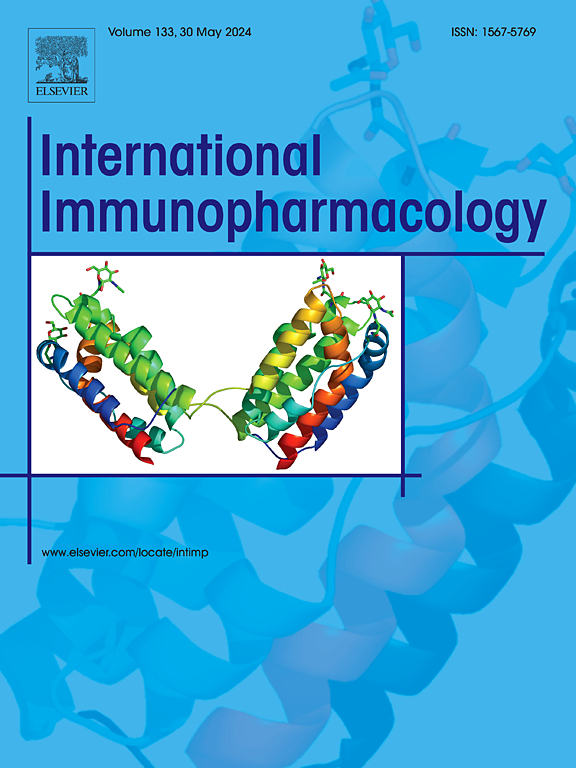过氧化物酶体增殖物激活受体(PPAR) α, β/δ和γ的潜力:对其分子机制,细胞信号传导,免疫反应和多种疾病治疗意义的深入和全面的综述
IF 4.8
2区 医学
Q2 IMMUNOLOGY
引用次数: 0
摘要
过氧化物酶体增殖激活受体(PPARs)是一种配体激活的转录因子,已成为各种生物过程的关键调节因子,突出了其在多种疾病的病理生理学和治疗中的相关性。人们主要认识到 PPARs 在脂质和葡萄糖代谢中的关键作用,这也是 PPARs 应用于治疗 2 型糖尿病的基础。除代谢紊乱外,PPAR 还因参与免疫调节而备受关注,成为治疗自身免疫相关炎症疾病的潜在靶点。此外,PPAR 还具有调节增殖、分化和凋亡的能力,这使它们成为肿瘤学领域前景广阔的候选药物。PPAR 的抗炎和抗纤维化特性进一步凸显了它们在皮肤病和心血管疾病中的潜力,因为这些疾病的炎症反应失调会导致疾病恶化。最近的研究进展阐明了不同 PPAR 异构体的分子机制,包括它们对 NF-κB 和 MAPK 等关键信号通路的调控,这些通路在炎症和细胞应激反应中至关重要。此外,它们与辅助因子的相互作用以及翻译后修饰进一步丰富了它们的功能作用。尽管与副作用和靶点特异性有关的挑战依然存在,但各种 PPAR 激动剂的治疗潜力已得到广泛探索。越来越多的证据凸显了 PPARs 在了解疾病的分子基础和促进治疗干预方面的重要意义,为广泛的医疗条件下的靶向治疗方法铺平了道路。在此,我们将从全面而详细的角度介绍 PPARs 及其在不同健康状况下的潜力,以加深我们的理解、阐明其潜在机制并促进潜在治疗策略的开发。本文章由计算机程序翻译,如有差异,请以英文原文为准。

Potentials of peroxisome proliferator-activated receptor (PPAR) α, β/δ, and γ: An in-depth and comprehensive review of their molecular mechanisms, cellular Signalling, immune responses and therapeutic implications in multiple diseases
Peroxisome proliferator-activated receptors (PPARs), ligand-activated transcription factors, have emerged as a key regulator of various biological processes, underscoring their relevance in the pathophysiology and treatment of numerous diseases. PPARs are primarily recognized for their critical role in lipid and glucose metabolism, which underpins their therapeutic applications in managing type 2 diabetes mellitus. Beyond metabolic disorders, they have gained attention for their involvement in immune modulation, making them potential targets for autoimmune-related inflammatory diseases. Furthermore, PPAR's ability to regulate proliferation, differentiation, and apoptosis has positioned them as promising candidates in oncology. Their anti-inflammatory and anti-fibrotic properties further highlight their potential in dermatological and cardiovascular conditions, where dysregulated inflammatory responses contribute to disease progression. Recent advancements have elucidated the molecular mechanisms of different PPAR isoforms, including their regulation of key signalling pathways such as NF-κB and MAPK, which are crucial in inflammation and cellular stress responses. Additionally, their interactions with co-factors and post-translational modifications further diversify their functional roles. The therapeutic potential of various PPAR agonists has been extensively explored, although challenges related to side effects and target specificity remain. This growing body of evidence underscores the significance of PPARs in understanding the molecular basis of diseases and advancing therapeutic interventions, paving way for targeted treatment approach across a wide spectrum of medical conditions. Here, we provide a comprehensive and detailed perspective of PPARs and their potential across different health conditions to advance our understanding, elucidate underlying mechanisms, and facilitate the development of potential treatment strategies.
求助全文
通过发布文献求助,成功后即可免费获取论文全文。
去求助
来源期刊
CiteScore
8.40
自引率
3.60%
发文量
935
审稿时长
53 days
期刊介绍:
International Immunopharmacology is the primary vehicle for the publication of original research papers pertinent to the overlapping areas of immunology, pharmacology, cytokine biology, immunotherapy, immunopathology and immunotoxicology. Review articles that encompass these subjects are also welcome.
The subject material appropriate for submission includes:
• Clinical studies employing immunotherapy of any type including the use of: bacterial and chemical agents; thymic hormones, interferon, lymphokines, etc., in transplantation and diseases such as cancer, immunodeficiency, chronic infection and allergic, inflammatory or autoimmune disorders.
• Studies on the mechanisms of action of these agents for specific parameters of immune competence as well as the overall clinical state.
• Pre-clinical animal studies and in vitro studies on mechanisms of action with immunopotentiators, immunomodulators, immunoadjuvants and other pharmacological agents active on cells participating in immune or allergic responses.
• Pharmacological compounds, microbial products and toxicological agents that affect the lymphoid system, and their mechanisms of action.
• Agents that activate genes or modify transcription and translation within the immune response.
• Substances activated, generated, or released through immunologic or related pathways that are pharmacologically active.
• Production, function and regulation of cytokines and their receptors.
• Classical pharmacological studies on the effects of chemokines and bioactive factors released during immunological reactions.

 求助内容:
求助内容: 应助结果提醒方式:
应助结果提醒方式:


